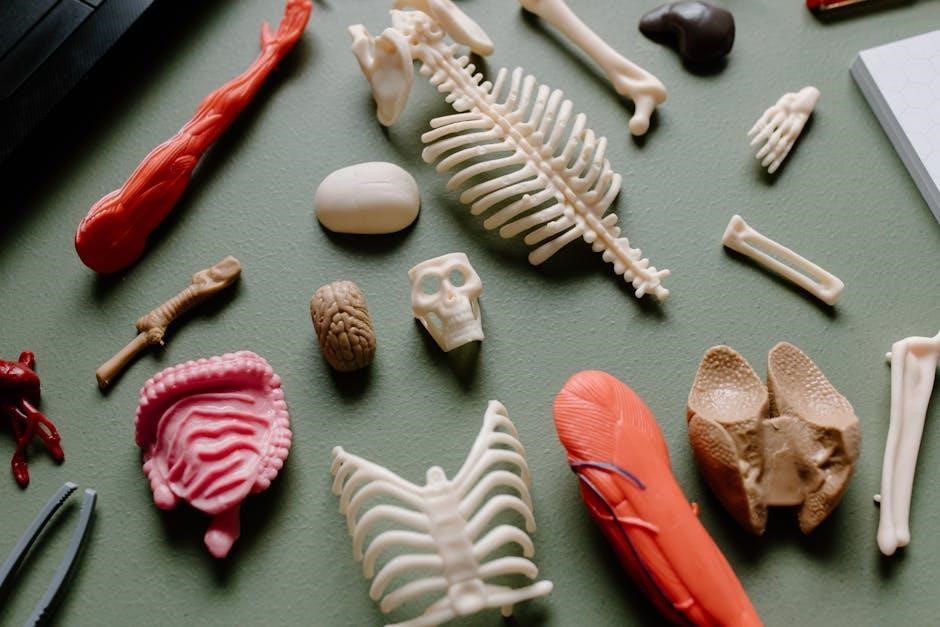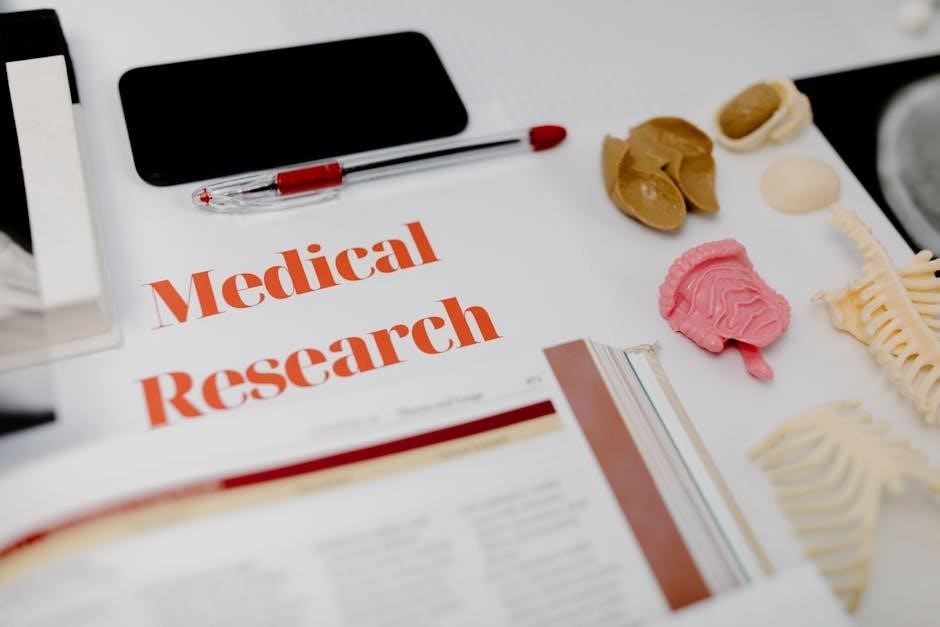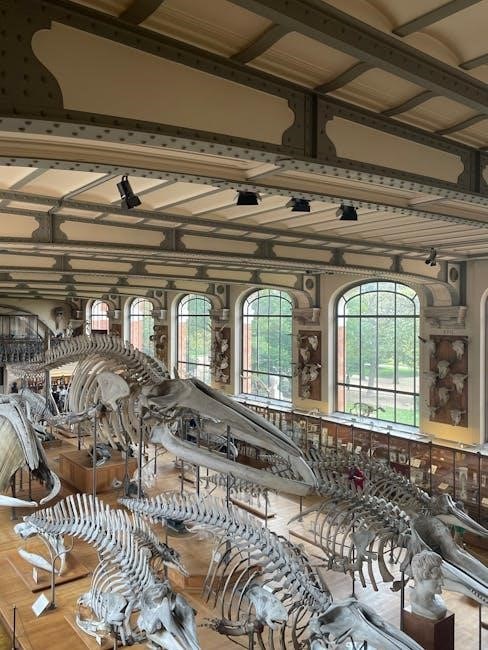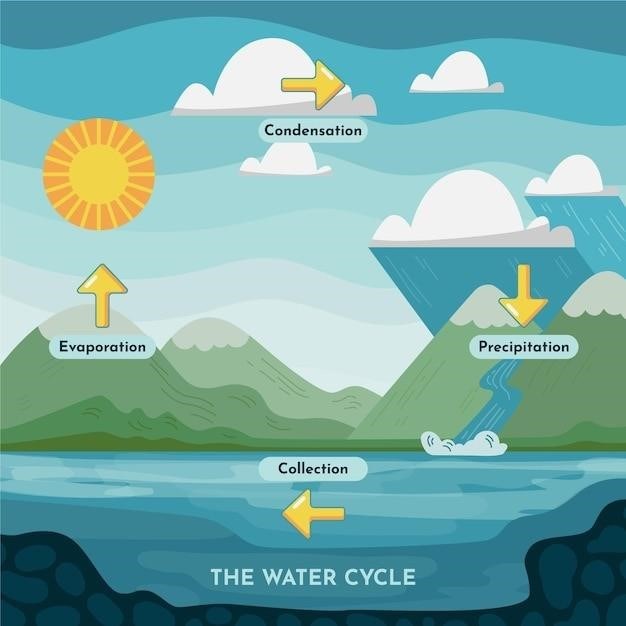skeleton system pdf
The skeletal system‚ comprising bones‚ joints‚ cartilage‚ ligaments‚ and tendons‚ provides support‚ enables movement‚ protects organs‚ and facilitates blood cell production and mineral storage.
1.1 Definition and Overview
The skeletal system is the framework of the human body‚ comprising bones‚ cartilage‚ ligaments‚ and tendons. It provides structural support‚ facilitates movement‚ and protects vital organs. The skeletal system is divided into two main parts: the axial skeleton and the appendicular skeleton. It works in conjunction with muscles‚ enabling mobility and maintaining posture. Understanding this complex system is essential for appreciating human anatomy and health. The skeletal system also plays a role in blood cell production and mineral storage‚ making it vital for overall bodily functions.
1.2 Importance of the Skeletal System
The skeletal system is crucial for maintaining posture‚ enabling movement‚ and protecting internal organs like the brain and heart. It also produces blood cells in bone marrow and stores minerals like calcium and phosphorus. This system provides structural support and facilitates muscle attachment‚ allowing for mobility. Its functions are essential for overall health‚ making it a vital component of human anatomy. Understanding its importance aids in preventing disorders and maintaining bodily functions effectively.
1.3 Structure and Components
The skeletal system consists of bones‚ cartilage‚ and ligaments‚ forming a framework that supports the body. It is divided into the axial and appendicular skeletons. Bones are composed of cortical (compact) and trabecular (spongy) bone tissue‚ with bone marrow producing blood cells. The periosteum covers bone surfaces‚ while the endosteum lines internal cavities. This structure allows for strength‚ flexibility‚ and growth‚ enabling the skeleton to adapt and repair throughout life. Its complex design ensures optimal functionality and durability.

Functions of the Skeletal System
The skeletal system provides structural support‚ facilitates movement‚ protects vital organs‚ produces blood cells‚ and stores essential minerals for bodily functions.
2.1 Support and Framework
The skeletal system acts as the body’s internal framework‚ providing structural support and maintaining posture. Bones like the skull‚ spine‚ ribcage‚ and limbs form a sturdy foundation‚ enabling the body to stand upright and move efficiently. This framework also serves as attachment points for muscles‚ allowing for movement and stability. Additionally‚ it protects vital organs and distributes weight evenly‚ ensuring optimal bodily functions and overall structural integrity. Its role is essential for maintaining balance and facilitating daily activities effectively.
2.2 Facilitating Movement
The skeletal system plays a vital role in enabling movement by providing a base for muscle attachment. Bones act as levers‚ while muscles pull on them to create motion. Joints allow bones to move in specific directions‚ such as hinge joints in the knees and ball-and-socket joints in the shoulders; This system works with muscles and ligaments to facilitate walking‚ running‚ and precise movements. The skeleton’s structure ensures efficient mobility while maintaining stability and balance‚ making it essential for all physical activities.
2.3 Protection of Internal Organs
The skeletal system provides essential protection for vital organs. The skull encases the brain‚ while the rib cage shields the heart‚ lungs‚ and liver. Vertebrae safeguard the spinal cord‚ and the pelvis protects reproductive organs. These bones act as a protective barrier‚ absorbing shocks and reducing the risk of injury to delicate tissues. This protective function is crucial for maintaining overall health and ensuring the survival of critical bodily systems.
2.4 Blood Cell Production
The skeletal system plays a vital role in blood cell production through bone marrow. Red bone marrow‚ found in spongy bones like the pelvis‚ sternum‚ and vertebrae‚ produces red blood cells‚ white blood cells‚ and platelets. This process‚ called hematopoiesis‚ is essential for oxygen transport‚ immune defense‚ and blood clotting. The skeletal system ensures a constant supply of blood cells‚ maintaining the body’s ability to function and respond to infections and injuries efficiently.
2.5 Mineral Storage and Regulation
The skeletal system acts as a reservoir for essential minerals like calcium and phosphorus‚ storing them in bone tissue. When the body needs these minerals‚ bones release them into the bloodstream. This process helps maintain mineral balance‚ which is crucial for muscle function‚ nerve signaling‚ and overall physiological health. The skeleton also regulates mineral levels through interactions with hormones‚ ensuring proper homeostasis and supporting various bodily functions effectively.

Bones of the Skeletal System
Bones store essential minerals like calcium and phosphorus‚ acting as a reservoir. They release these minerals into the bloodstream when needed‚ maintaining mineral balance and supporting bodily functions.
3.1 Types of Bones
Bones are classified into five types based on their shape and function. Long bones‚ like the femur and humerus‚ are elongated and support movement. Short bones‚ such as carpals and tarsals‚ provide stability. Flat bones‚ including skull and rib bones‚ protect internal organs. Irregular bones‚ like vertebrae and pelvic bones‚ have unique shapes for protection and support. Sesamoid bones‚ such as the patella‚ are embedded in tendons to enhance muscle function. Each type adapts to specific roles in the body.
3.2 Bone Tissue and Structure
Bones are composed of two types of tissue: compact and spongy bone. Compact bone forms the dense outer layer‚ providing strength‚ while spongy bone is lighter and found inside bones. The periosteum‚ a fibrous membrane‚ covers bones‚ aiding in growth and repair. Bones also feature a medullary cavity filled with bone marrow. The structure includes the diaphysis (shaft) and epiphysis (ends) in long bones. This complex architecture supports the skeletal system’s functions of support‚ movement‚ and protection‚ while also facilitating blood cell production and mineral storage.
3.3 Bone Growth and Development
Bone growth occurs through two main processes: intramembranous and endochondral ossification. Intramembranous ossification forms flat bones directly from connective tissue‚ while endochondral ossification involves cartilage templates gradually replacing with bone tissue. Growth continues into adolescence‚ with epiphyseal plates expanding bone length. Hormones like growth hormone and thyroid hormone regulate this process. Bones also increase in density through mineralization‚ primarily calcium and phosphorus. This dynamic process ensures skeletal development and strength‚ adapting to physical demands throughout life while maintaining structural integrity and functionality.
3.4 Classification of Bones
Bones are classified into five types based on shape and function: long‚ short‚ flat‚ irregular‚ and sesamoid. Long bones‚ like the femur‚ have greater length than width and support body weight. Short bones‚ such as carpals‚ are cube-shaped and provide stability. Flat bones‚ like the skull‚ protect internal organs. Irregular bones‚ such as vertebrae‚ have unique shapes for specific functions. Sesamoid bones‚ like the patella‚ are embedded in tendons to reduce friction. This classification aids in understanding skeletal structure and function.

Axial Skeleton
The axial skeleton forms the body’s central framework‚ comprising the skull‚ vertebral column‚ rib cage‚ and sternum. It provides structural support and protects vital organs.
4.1 Skull and Facial Bones
The skull and facial bones form the cranial and facial structures‚ comprising 22 bones in total. The cranium protects the brain‚ while facial bones support sensory organs like eyes‚ nose‚ and mouth. Cranial bones fuse in adulthood‚ forming a solid structure. Facial bones‚ including the mandible‚ maxilla‚ and zygoma‚ facilitate functions like chewing‚ speaking‚ and breathing. Together‚ they create a protective framework essential for sensory and motor functions‚ while also contributing to facial aesthetics and identity.
4.2 Vertebral Column
The vertebral column‚ or backbone‚ consists of 33 vertebrae divided into five regions: cervical‚ thoracic‚ lumbar‚ sacrum‚ and coccyx. It provides structural support‚ protects the spinal cord‚ and facilitates movement. Cervical vertebrae support the head‚ thoracic vertebrae connect to the rib cage‚ and lumbar vertebrae bear significant body weight. The sacrum and coccyx are fused‚ forming the pelvis base and tailbone. This column acts as a flexible yet sturdy framework‚ enabling posture‚ balance‚ and mobility while safeguarding vital neural structures.
4.3 Rib Cage and Sternum
The rib cage‚ formed by 12 pairs of ribs and the sternum‚ protects vital organs like the heart and lungs. The sternum‚ or breastbone‚ connects the ribs anteriorly‚ while the vertebral column anchors them posteriorly. True ribs directly attach to the sternum‚ while false ribs connect via cartilage. Floating ribs lack a sternal connection. This structure provides a protective cage‚ aids in breathing by allowing rib movement‚ and serves as a muscle attachment site for upper limb movements‚ enhancing both stability and functionality in the upper body.

Appendicular Skeleton
The appendicular skeleton includes the upper and lower limb bones‚ pelvis‚ and shoulder girdle‚ providing support and enabling movement. It connects to the axial skeleton via the pelvis and shoulder‚ facilitating mobility and stability in the body’s extremities.
5.1 Upper Limb Bones
The upper limb bones include the humerus‚ radius‚ ulna‚ carpals‚ metacarpals‚ and phalanges. The humerus forms the arm‚ while the radius and ulna make up the forearm. Carpals are wrist bones‚ metacarpals form the hand‚ and phalanges are finger bones. These bones provide structural support and enable movements like flexion‚ extension‚ and rotation. They articulate with the shoulder and pelvic girdles‚ facilitating a wide range of activities‚ from fine motor skills to heavy lifting. Their arrangement ensures both mobility and stability in the upper limbs.
5.2 Lower Limb Bones
The lower limb bones include the femur‚ patella‚ tibia‚ fibula‚ tarsals‚ metatarsals‚ and phalanges. The femur is the longest bone‚ forming the thigh. The patella (kneecap) protects the knee joint. The tibia and fibula make up the lower leg‚ with the tibia supporting most body weight. The tarsals form the ankle‚ metatarsals the arch‚ and phalanges the toes. These bones enable standing‚ walking‚ and balance‚ while providing attachment points for muscles and ligaments.
5.3 Pelvis and Shoulder Girdle
The pelvis and shoulder girdle are crucial components of the appendicular skeleton. The pelvis is a sturdy structure formed by the fusion of the ilium‚ ischium‚ and pubis bones‚ providing a base for the spinal column and transferring weight to the lower limbs. The shoulder girdle‚ consisting of the clavicle and scapula‚ offers a wide range of motion for the upper limbs. Together‚ they connect the upper and lower body‚ enabling both stability and flexibility in movement.

Joints and Their Types
6.1 Classification of Joints
The classification of joints‚ also known as articulations‚ is based on their ability to move and the presence of a space between bones. There are three main types: synarthroses (immovable joints)‚ amphiarthroses (slightly movable joints)‚ and diarthroses (freely movable joints). Synarthroses‚ like the joints in the skull‚ allow no movement. Amphiarthroses‚ such as the vertebrae‚ permit limited movement. Diarthroses‚ including hinge‚ ball-and-socket‚ pivot‚ saddle‚ and gliding joints‚ enable extensive movement‚ facilitating activities like walking and running.
6.2 Structure and Function of Joints
Joints‚ or articulations‚ are points where two or more bones meet‚ enabling movement and stability. The structure of a joint includes bones‚ cartilage‚ ligaments‚ and synovial fluid; Cartilage covers the bone ends‚ reducing friction‚ while synovial fluid lubricates the joint. Ligaments connect bones‚ providing support and limiting excessive movement. The function of joints varies‚ from allowing flexible movements like bending to providing stability in weight-bearing areas. This complex structure ensures efficient mobility while protecting the bones from wear and tear.
6.3 Importance of Joints in Movement
Joints are essential for enabling movement by allowing bones to articulate and flex. They provide the necessary flexibility for actions like walking‚ running‚ and bending. Without joints‚ the skeletal system would be rigid‚ making movement impossible. Joints also reduce friction between bones‚ preventing wear and tear. Different types of joints‚ such as hinge‚ ball-and-socket‚ and pivot joints‚ facilitate a wide range of motions. This adaptability ensures the body can perform both voluntary and involuntary movements efficiently.

Cartilage‚ Ligaments‚ and Tendons
Cartilage‚ ligaments‚ and tendons are essential connective tissues in the skeletal system. Cartilage provides cushioning and flexibility in joints‚ while ligaments stabilize bones and joints. Tendons connect muscles to bones‚ enabling movement and strength. Together‚ they enhance mobility and structural integrity.
7.1 Role of Cartilage
Cartilage is a flexible‚ yet strong connective tissue that plays a crucial role in the skeletal system. It acts as a cushion between bones‚ reducing friction and absorbing shock during movements. Found in joints‚ ears‚ nose‚ and between vertebrae‚ cartilage facilitates smooth motion and protects bones from wear. It also serves as a precursor for bone growth during development. There are three types: hyaline‚ elastic‚ and fibrocartilage‚ each with unique functions tailored to their locations.
7.2 Function of Ligaments
Ligaments are strong‚ fibrous connective tissues that connect bones to other bones‚ providing stability and support to joints. Their primary function is to hold bones together‚ allowing for limited movement while preventing excessive joint mobility. Ligaments play a crucial role in maintaining joint integrity‚ ensuring proper alignment‚ and enabling smooth‚ coordinated movements. They act as restraints‚ protecting joints from injury by limiting flexibility beyond their natural range. Ligaments are essential for maintaining posture and facilitating activities like walking‚ running‚ and bending. Their strength and elasticity are vital for joint health and overall mobility.
7.3 Importance of Tendons
Tendons play a crucial role in the skeletal system by connecting muscles to bones‚ enabling movement. They are tough‚ fibrous cords that transmit muscle forces to bones‚ allowing precise control over motion. Without tendons‚ muscles cannot exert force on bones‚ making movement impossible. Tendons also provide mechanical strength and stability‚ ensuring efficient energy transfer during activities like walking or lifting. Their elasticity allows for shock absorption‚ protecting joints from stress. Overall‚ tendons are essential for mobility and maintaining skeletal functionality.

Disorders and Injuries of the Skeletal System
The skeletal system is susceptible to various disorders and injuries‚ including osteoporosis‚ fractures‚ and arthritis. These conditions often result from aging‚ poor diet‚ or traumatic incidents‚ impacting mobility and quality of life.
8.1 Common Skeletal Disorders
The skeletal system is susceptible to various disorders that affect its structure and function. Osteoporosis‚ a condition characterized by bone thinning‚ increases fracture risk‚ especially in older adults. Arthritis‚ including osteoarthritis and rheumatoid arthritis‚ causes joint pain and stiffness. Osteogenesis imperfecta is a genetic disorder leading to brittle bones. Scoliosis involves an abnormal spinal curvature‚ often diagnosed in childhood. These conditions highlight the importance of early diagnosis and proper management to maintain skeletal health and mobility.
8.2 Types of Bone Fractures
Bone fractures are classified into various types based on their characteristics and severity. The most common types include complete fractures‚ where the bone breaks entirely‚ and incomplete fractures‚ where the bone cracks but doesn’t separate. Fractures can also be categorized as transverse (straight across the bone)‚ oblique (diagonal)‚ or spiral (twisting around the bone). Additionally‚ fractures are described as open (breaking the skin‚ increasing infection risk) or closed (no skin break). Proper diagnosis and treatment are crucial for recovery.
8.3 Treatment and Recovery
Treatment and recovery for skeletal injuries or disorders depend on the severity and type of condition. Common treatments include immobilization using casts or braces‚ pain management through medication‚ and in severe cases‚ surgery. Physical therapy is often recommended to restore mobility and strength. Additionally‚ lifestyle modifications such as a balanced diet and regular exercise can aid recovery. The healing process varies‚ with some injuries taking weeks to heal and others requiring months of rehabilitation. Rest and proper medical care are crucial for full recovery.

Diagnostic Techniques for Skeletal System
Various imaging techniques like X-rays‚ CT scans‚ and MRIs are used to diagnose skeletal disorders. These tools provide detailed visuals of bones and tissues‚ aiding in accurate diagnosis and monitoring of conditions like fractures‚ osteoporosis‚ and tumors.
9.1 X-rays and CT Scans
X-rays are a fundamental diagnostic tool for examining the skeletal system‚ providing clear images of bone structures to identify fractures‚ osteoporosis‚ or tumors. They are non-invasive and widely used due to their accessibility. CT scans offer more detailed cross-sectional images‚ enhancing the visualization of complex fractures or spinal injuries. Both techniques are essential for accurate diagnoses‚ enabling healthcare professionals to assess bone health and plan appropriate treatments. They complement each other in providing comprehensive insights into skeletal conditions.
9.2 MRI and Bone Densitometry
Magnetic Resonance Imaging (MRI) provides detailed images of bones and surrounding tissues‚ helping diagnose fractures‚ tumors‚ and spinal issues. Bone densitometry‚ such as DEXA scans‚ measures bone mineral density to assess osteoporosis risk. These non-invasive tools are crucial for early detection and monitoring of skeletal conditions‚ ensuring timely treatment and improved patient outcomes.
9.4 Role of Biopsy in Skeletal Disorders
A biopsy is a diagnostic procedure where a bone or tissue sample is examined to identify abnormalities. It is often used to diagnose infections‚ cancers‚ or degenerative bone diseases. During a biopsy‚ a small tissue sample is extracted using a needle or surgical procedure and analyzed under a microscope. This method provides precise information about the condition of the skeletal tissue‚ helping in accurate diagnosis and appropriate treatment planning for various skeletal disorders.

Study Resources for the Skeletal System
Access detailed PDF guides‚ diagrams‚ and study materials online. Utilize 3D models‚ tutorials‚ and quizzes. Download comprehensive PDFs covering skeletal anatomy‚ functions‚ and disorders.
- Recommended study guides in PDF format provide detailed notes and visuals.
- Online tools offer 3D models and simulations for interactive learning.
- Worksheets and quizzes test knowledge and reinforce key concepts effectively.
10.1 Recommended Study Guides
For comprehensive learning‚ top-rated PDF study guides on the skeletal system include “Human Skeleton System Guide” and “Anatomy of Bones and Joints.” These resources provide detailed diagrams‚ bone classifications‚ and functional explanations. Additionally‚ “Skeletal System Workbook” offers interactive exercises for hands-on practice. For advanced learners‚ “Gray’s Anatomy” in PDF format is an excellent choice‚ covering intricate skeletal details. These guides ensure a thorough understanding of the skeletal system‚ making them ideal for both students and professionals.
10.2 Online Tools and Tutorials
Online tools and tutorials provide interactive and engaging ways to study the skeletal system. Websites like Kenhub and Visible Body offer 3D skeletal models‚ allowing users to explore bone structures in detail. Video tutorials on YouTube channels such as Anatomy Zone explain complex concepts visually. Interactive quizzes and labeling exercises on platforms like Quizlet help reinforce knowledge. Additionally‚ virtual lab simulations enable students to practice bone identification and learn about joint movements. These resources make learning about the skeleton system accessible and enjoyable.
10.3 Worksheets and Quizzes
Worksheets and quizzes are essential tools for reinforcing knowledge about the skeletal system. They provide interactive ways to test understanding and retention of key concepts. Worksheets often include labeling exercises‚ crossword puzzles‚ and short-answer questions‚ while quizzes assess comprehension through multiple-choice‚ true/false‚ and fill-in-the-blank formats. These resources help students identify areas needing further study and ensure a solid grasp of skeletal system anatomy and functions. Regular use of worksheets and quizzes can significantly enhance learning outcomes and preparation for exams.
The skeletal system is a vital framework essential for movement‚ support‚ and protection. Understanding its structure‚ functions‚ and disorders is crucial for maintaining overall health and well-being.
11.1 Summary of Key Points
The skeletal system is a complex framework providing support‚ movement‚ and protection. It consists of bones‚ cartilage‚ ligaments‚ and tendons. The axial skeleton includes the skull‚ vertebral column‚ and rib cage‚ while the appendicular skeleton comprises limbs and girdles. Bones store minerals‚ produce blood cells‚ and facilitate movement. Joints enable flexibility‚ and connective tissues stabilize structures. Understanding this system aids in diagnosing disorders and injuries‚ emphasizing its vital role in overall health and bodily functions.
11.2 Importance of Understanding the Skeletal System
Understanding the skeletal system is crucial for maintaining overall health and preventing injuries. It helps in identifying potential issues early‚ such as fractures or degenerative conditions. Knowledge of bone structure and function aids in managing conditions like osteoporosis and arthritis. Additionally‚ it enhances appreciation for the body’s mechanics‚ supporting physical activity and rehabilitation. Studying the skeletal system is essential for medical professionals and individuals seeking to improve bone health and prevent future complications.


